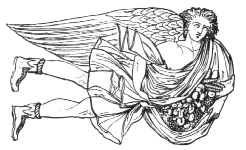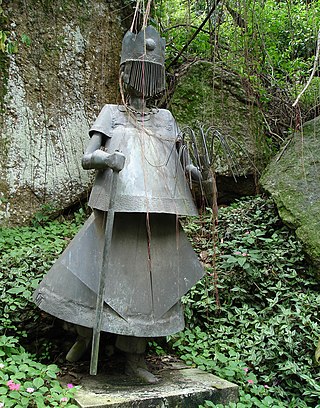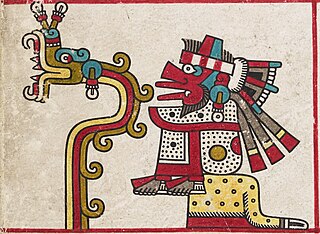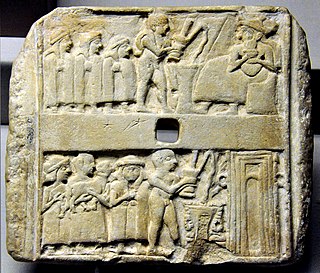
In Greek mythology, Astraeus or Astraios is an astrological deity. Some also associate him with the winds, as he is the father of the four Anemoi, by his wife, Eos.

In Aztec mythology, Chicōmecōātl "Seven Serpent", was the Aztec goddess of agriculture during the Middle Culture period. She is sometimes called "goddess of nourishment", a goddess of plenty and the female aspect of maize.

In Aztec mythology, Mētztli was a god or goddess of the moon, the night, and farmers. They were likely the same deity as Yohaulticetl or Coyolxauhqui and the male moon god Tecciztecatl; like the latter, who feared the Sun because of its fire.

Ọya is an Orisha of winds, lightning, and violent storms. As a river deity she is also regarded as a deity of children, able to provide children to her devotees or those who come to her banks at the Niger river.

Vayu, also known as Vata and Pavana, is the Hindu god of the winds as well as the divine messenger of the gods. In the Vedic scriptures, Vayu is an important deity and is closely associated with Indra, the king of gods. He is mentioned to be born from the breath of Supreme Being Vishvapurusha and also the first one to drink Soma. The Upanishads praise him as Prana or 'life breath of the world'. In the later Hindu scriptures, he is described as a dikpala, who looks over the north-west direction. The Hindu epics describe him as the father of the god Hanuman and Bhima.

Fūjin or Fūten, sometimes also known as Ryobu, is the Japanese god of the wind and one of the eldest Shinto gods. He is portrayed as a terrifying wizardly demon, resembling a red-haired, green-skinned humanoid wearing a tiger or leopard skin loincloth/kilt, carrying a large bag of winds on his shoulders. In Japanese art, the deity is often depicted together with Raijin, the god of lightning, thunder and storms.
Shinatsuhiko is a Japanese mythological god of wind (Fūjin). Another name for this deity is Shinatobe, who originally may have been a separate goddess of wind.
The Banrawats are a native endangered ethnic minority group, originating and living in Uttarakhand, India. They are distributed in the districts of Pithoragarh, Champawat and Udham Singh Nagar and in a small area confined to Western Nepal. They are the smallest Himalayan tribal group related to a larger ethno-linguistic group of Raji people. They are basically nomadic hunter-gatherers, but also work as agriculture and forest labourers. They are mainly dependent on forests, and also practice shifting cultivation. Their existence is threatened by developmental and wild life related projects. They were placed in forced settlements by the Government of India beginning in the 1980s. Many continue to move in semi-nomadic camps, but most are now settled into villages along the Mahakali River area straddling India.

In ancient Greek religion and myth, the Anemoi were wind gods who were each ascribed a cardinal direction from which their respective winds came, and were each associated with various seasons and weather conditions. They were the progeny of the goddess of the dawn Eos and her husband, the god of the dusk, Astraeus.

In the Dungeons & Dragons (D&D) role-playing game, Bahamut is a powerful draconic deity, who has the same name as Bahamut from Arabic mythology.
A south wind is a wind that originates in the south and blows in a northward direction.

The fundamental practice of Vajrayana and Tibetan tantra is deity yoga (devatayoga), meditation on a chosen deity or "cherished divinity", which involves the recitation of mantras, prayers and visualization of the deity, the associated mandala of the deity's Buddha field, along with consorts and attendant Buddhas and bodhisattvas. According to the Tibetan scholar Tsongkhapa, deity yoga is what separates Tantra from Sutra practice.

A weather god or goddess, also frequently known as a storm god or goddess, is a deity in mythology associated with weather phenomena such as thunder, snow, lightning, rain, wind, storms, tornadoes, and hurricanes. Should they only be in charge of one feature of a storm, they will be called after that attribute, such as a rain god or a lightning/thunder god. This singular attribute might then be emphasized more than the generic, all-encompassing term "storm god", though with thunder/lightning gods, the two terms seem interchangeable. They feature commonly in polytheistic religions, especially in Proto-Indo-European ones.
The Vayu Stuti is a stuti (eulogy) composed by Trivikrama Panditacharya addressed to Madhvacharya, the founder of the Dvaita school of philosophy. The hymn praises Madhvacharya as the third incarnation of the god of the wind, Vayu, after Hanuman and Bhima, a belief held by members of the Madhva tradition.

Quetzalcoatl is a deity in Aztec culture and literature. Among the Aztecs, he was related to wind, Venus, Sun, merchants, arts, crafts, knowledge, and learning. He was also the patron god of the Aztec priesthood. He was one of several important gods in the Aztec pantheon, along with the gods Tlaloc, Tezcatlipoca and Huitzilopochtli. The two other gods represented by the planet Venus are Tlaloc and Xolotl.

Sumerian religion was the religion practiced by the people of Sumer, the first literate civilization found in recorded history and based in ancient Mesopotamia, and what is modern day Iraq. The Sumerians widely regarded their divinities as responsible for all matters pertaining to the natural and social orders of their society.

Heifeng Guai, also translated as the Black Wind Demon, is a character from the 16th century Chinese novel Journey to the West. He is a demon based in a cave on Black Wind Mountain (黑風山). His true form is a black bear, thus the demon is also known as the Black Bear Monster, but he appears as a dark-complexioned man armed with a Black Tassel Spear.











